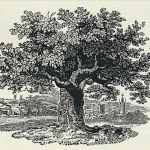I have written a few articles recently concerning the neighborhood of Bowne Station (“The Daybooks of Dr. Bowne,” “The Bowne Homestead,” “Bowne Station” and “The Bosenbury and Taylor Graveyards”), and have frequently come across references to the first settlers in that area, one Jacob Moore and his wife, Apolonia Amy Moret. Just when I thought I had published all articles by Egbert T. Bush and Jonathan M. Hoppock pertaining to the early history of the Moore family in Amwell, another one turned up. Actually, two articles, “Old Farms in Old Hunterdon” and “Farewell Relic of Another Age.”
Historians Revisited
The Bosenbury and Taylor Graveyards
This post is published in conjunction with a recent article on Bowne Station, because in that article Mr. Bush recalled the Bosenbury family, and the trouble they had burying old Cornelius Bosenbury. In this article, Mr. Bush went looking for that cemetery.
Bowne Station
This article by Egbert T. Bush answers some questions about the Bowne farm that were raised in the previous post, “Dr. Bowne’s Homestead.“1 Lora Olsen had pointed out that there were two houses on the property, one quite old, and one built in the mid 19th century. But it turns out there was a third house—one built for the slaves that lived on the farm.
Dr. Bowne’s Homestead
This article is meant as a companion to the article by Egbert T. Bush, “The Daybooks of Dr. Bowne.” In this article, Mr. Hoppock goes on at some length about the first owner of the Bowne farm being Jacob Moore. Unfortunately, he was mistaken. As Mr. Bush wrote, Jacob Moore settled on what later became known as the Wagner farm (at Haines and Wagner Roads). The Bowne farm was first settled by Peter Moore, but Mr. Bush does not say when he settled there. It was certainly early, because Peter Moore’s executors (his three sons) sold the farm to Dr. Bowne in 1795.
The Daybooks of Dr. Bowne
Recently I attended a workshop given by archivist Don Cornelius on the holdings of the Hunterdon County Historical Society. They are extensive, far more than I realized. Among them are the original daybooks of Dr. John Bowne of old Amwell Township, filled with the names of his patients and their treatment. These Daybooks are so important to genealogists that someone at the Historical Society has gone to the considerable effort of indexing the names into a card catalog, and—primitive as it may seem to be today—it’s a very useful genealogical tool for the time period of 1791 through 1857.
Much Mischief Was Blamed on a Witch
The Good Old People Could Identify Her and Tell of Her Doings
She Rode on a Broomstick
by Egbert T. Bush, Stockton, N.J.
published in the Hunterdon County Democrat, May 1, 1930
A Pirate in Old Amwell
When writing about Pine Hill Cemetery recently, the name of John Lewis came up. This reminded me of a wonderful article written by Jonathan M. Hoppock back in 1905 about a mysterious character named Ticnor Lewis who lived not far from Pine Hill. It is one of Mr. Hoppock’s most colorful yarns, and one of his many stories of the early settlers in Amwell Township. This one is based entirely on folklore or family tradition. A bowl-full of salt is highly recommended.
A Barn Raising Was A Big Event
Feeding Fifty Men Was Not Uncommon on Such an Occasion
Eatables in Great Abundance
by Egbert T. Bush, Stockton, N.J.
originally published by the Hunterdon Co. Democrat, July 24, 1930
Note: I have included the punctuation as it appeared in the original article, even though I disagree with the editor’s use of commas, and wonder if that was how Mr. Bush wrote it. Also, when Mr. Bush refers to “the young generation,” he means people born in the late-19th and early 20th-century. Mr. Bush was born in 1848.
Old Barns Were Built For The Ages
Processes of Lining, Scoring, Boring and Hewing Described
‘The Big Thrashing Floor’
by Egbert T. Bush, Stockton, N. J.
published in the Hunterdon County Democrat, July 17, 1930
There is no genealogy in this article; it is simply about how to build a barn.
